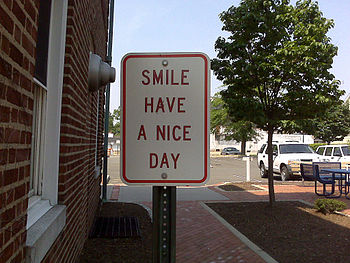I smiled at her. She relaxed. I kept looking at her with a soft toothless smile. Her eyes widened a bit. She smiled back, disarmed. Her face said, “You see me and you like who you see.” Her response evokes joy from me. A small virtuous circle swirls upward.
This happened with both my girls, Evie and Ellie. It’s occurred multiple times. It’s part of an experiment I’m doing.
I started experimenting with shaping my environment this year. The experiment consists of new rituals:
Inspirational videos
I listen to positive, inspirational videos on my commute. The videos change my environment as an external stimulus.
Gratitude Statements
I repeat statements of gratitude and thankfulness on waking. Thankfulness for my amazing wife, my wonderful kids, my safe home, work to do, a car to get to work, owning a coat on cold days. The gratitude shapes my environment internally via thought and a focus on what I’m blessed with.
Simple affirmations
I start my day with simple “I am” statements (I am joyful, I am peaceful, I am pleasant, I am persistent, etc). I start my day with them, repeat them while commuting and use them when I feel myself growing weary, tired or frustrated. The affirmations shape my environment internally via thought and plant seeds of what I am capable of independent of circumstances.
Smiling
I smile for a minute early in the day with wide open eyes. And I’m working on adjusting my default facial expression. I work to show a soft smile with lifted brow or at least a neutrally pleasant face. The smile is intended to shape my environment via action.
Smiling is the latest addition to the experiment. The smile was added after reading about multiple pieces of academic research. The research indicates smiling shapes the smilers mood. It works whether the smile is genuine or not.
My default face was Resting Angry Face (my revision of the RBF term – google it, if you must). I looked serious to angry. My facial expressions were hyper-responsive and intense. Most of the time, the expressions were negative. People would ask me “What’s wrong?” throughout the day. If I was thinking deeply – the look was angry. If I’m looking for an answer, my eyes will roll around literally searching for an answer – the look was a contemptful eye-roll. If I was reading something on my screen, my brow and eyes scrunched – grumpy. If someone was speaking and I was listening intently – more anger. Forty-six years in, I realized, this is a problem.
The smile experiment is producing an interesting, unexpected result. It appears smiling shapes others around you. I’m learning a ridiculously simple lesson. Look pleasant and people relax and become more pleasant in return. Strangers smile at me. People I know are quicker to smile.
I’m receiving fewer questions about “What’s wrong? Are you angry?” The opposite question was asked, “What’s with this expression, how come you’re not reacting?” The question coming after a frustrating interaction. It indicated I might be learning to control my hyper-responsive facial reactions.
Most importantly, my smile changes my kids. My daughters respond with more warmth. Even when disciplining, they don’t cower, they’ll cuddle. We’re finding ways to be joyful even when there’s conflict or consequence. The girls are more relaxed and playful.
I’m so glad, I discovered this while they’re 6. I don’t like that they lived the first six years of their life under the darkness of a permanent scowl. I can’t change the first six years. I can change myself going into the remaining lifetime.
It’s hyperbole but “When you’re smiling, the whole world smiles at you”. And if it doesn’t … I can choose to keep smiling anyway.
I am joyful. I am peaceful. I am pleasant. I am persistent.
